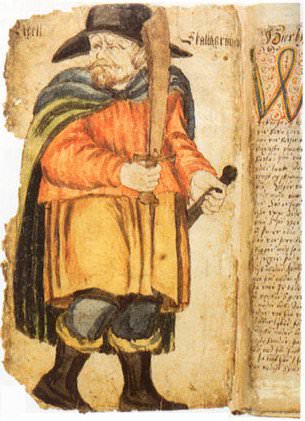‘í litklæðum’ – Coloured Clothes in Medieval Scandinavian Literature and Archaeology
What do we mean by coloured clothes? Or rather, what did the saga writers mean by their term litklæði?
Horses as Status Symbols: Medieval Icelandic horses as symbols of masculine honor in a one-sexed world
Horses, the unsung heroes of the Viking age, have been overlooked all too often in the study of medieval Iceland and its culture.
The Saga of the Confederates: Historical Truth in an Icelandic Saga
The Saga of the Confederates, written anonymously in the thirteenth century, tells a story that takes place in eleventh century Iceland. The saga presents an opportunity to examine Iceland’s unique political and social systems during the Middle Ages, both during the time of the story and also during the author’s lifetime.
Evidence and Intuition: Making Medieval Instruments
Evidence and Intuition: Making Medieval Instruments Adelman, Beth Early Music America (Fall 2005) Abstract The Atlakvida (The Lay of Attila), an 8th-or early 9th-century…
Scholar finds evidence of links between Vikings and North American natives
Old Norse sagas such as Saga of Erik the Red and the Saga of the Greenlanders have been long been considered among the…
Beauty and brutality: Iceland’s literary landscapes
Dr Emily Lethbridge is breathing new life and understanding into the centuries-old Sagas of Icelanders (Íslendingasögur) during a unique year-long research trip – conducted in 2011 from the back of a decommissioned Land Rover ambulance.
A Chieftain in an Old Norse Text: Sveinn Ásleifarson and the Message behind Orkneyinga Saga
A Chieftain in an Old Norse Text: Sveinn Ásleifarson and the Message behind Orkneyinga Saga By Ian Beuermann Confluence. Interdisciplinary Communications 2007/2008, edited…
Characters and Narrators as Interpreters of Fidelity Tests in Medieval Arthurian Fiction
Characters and Narrators as Interpreters of Fidelity Tests in Medieval Arthurian Fiction Besamusca, Bart Neophilologus (2010) Abstract This article discusses a number of fidelity-testing…
“Ek Skal Hér Ráða”: Themes of Female Honor in the Icelandic Sagas
“Ek Skal Hér Ráða”: Themes of Female Honor in the Icelandic Sagas Rivenbark, Susan Elizabeth (University of North Carolina at Wilmington) M.A. Thesis, Appalachian…
Viking Travellers of the Sagas
In accordance with the Icelandic sagas’ tendency to show rather than tell, it is rare for saga characters to say explicitly what motivates them to travel from their homes in Scandinavia and Iceland to distant lands
Judging Vikings: Ethics and morality in two Icelandic family sagas, Laxdaela saga and Vatnsdaela saga
To discern these ethics it seemed to be the right way not to look at the religious aspects of the saga, but just by looking at how the people behaved and how they are judged. For this purpose, one needs sagas that have interesting conflicts.
Selective female infanticide as partial explanation for the dearth of women in Viking Age Scandinavia
‘So you are with child. If you should bear a girl, it shall be exposed, but if a boy, then it shall be raised.’ –
Disfigurement, Disability, and Dis-integration in Sturlunga saga
Disfigurement, Disability, and Dis-integration in Sturlunga saga By Lois Bragg Alvíssmál, Vol. 4 (1994 [1995]) Introduction: Near the end of Sturlunga saga, an…
The Age of the Sturlungs
The thirteenth century occupies a special place in Icelandic history.
Peace Unwoven: Transgressive Women in Old Icelandic Heroic and Mythological Literature, and in Saxo Grammaticus’ Gesta Danorum
‘To that end I have done all things, so that King Siggeir should go to his death. I have also granted so much to happen so that vengeance be brought about, that for me there is no choice of life. I shall now die with King Siggeir willingly, while I married him unwilling.’
‘í litklæðum’ – Coloured Clothes in Medieval Scandinavian Literature and Archaeology
What do we mean by ‘coloured clothes’? Or rather, what did the saga writers mean by their term litklæði?
The Viking Sagas to be aired on BBC 4
The BBC will be airing a show examining Iceland’s medieval history this week. The Viking Sagas will first be see on Tuesday, May…
The Werewolf in Medieval Icelandic Literature
In northern regions much prominence is given to two kinds of shape-shifting: the ability to change into either a bear or a wolf, although the latter seems to have been more popular.
The Colour Green in Medieval Icelandic Literature: Natural, Supernatural, Symbolic?
The Colour Green in Medieval Icelandic Literature: Natural, Supernatural, Symbolic? By Anna Zanchi Paper given at the Thirteenth International Saga Conference (2006) Introduction: According…
Preserving the body Christian: the motif of “recapitation” in Ireland’s medieval hagiography
Preserving the body Christian: the motif of “recapitation” in Ireland’s medieval hagiography Johnson, Máire The Heroic Age A Journal of Early Medieval Northwestern Europe Issue 10—Saints…
Some observations on martyrdom in post-conversion Scandinavia
Some observations on martyrdom in post-conversion Scandinavia By Haki Antonsson Saga Book, Vol.28 (2004) Introduction: The Irish Cogadh Caedhal Re Gallaibh (‘The War…
Viking weather-vane practices in medieval France
This paper discusses the apparent influence and, even, spread of Viking weather-vane practices to countries outside the Scandinavian area.
The Mythical Method in Song and Saga, Prose and Verse: Part One
The Mythical Method in Song and Saga, Prose and Verse: Part One Nohrnberg, James C. Arthuriana 21.1 (2011) Abstract T.S. Eliot’s ‘mythical method’ is…
Discretion and deceit: a re-examination of a military stratagem in Egils saga
Discretion and deceit: a re-examination of a military stratagem in Egils saga By Ian McDougall The Middle Ages in the Northwest: papers presented…
Female Experience and Authorial Intention in Laxdœla saga
Female Experience and Authorial Intention in Laxdœla saga By Loren Auerbach Saga Book, Vol.25 (1998) Introduction: Much has been made of Laxdœla saga…




